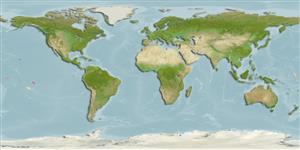>
Blenniiformes (Blennies) >
Blenniidae (Combtooth blennies) > Salariinae
Etymology: Entomacrodus: Greek, ento = inside + Greek, makros = big + Greek, odous = teeth (Ref. 45335); macrospilus: macrospilus meaning large spot, in reference its head spot (Ref. 40910).
Environment: milieu / climate zone / depth range / distribution range
Ecologia
marinhas; intervalo de profundidade 0 - 8 m (Ref. 54980). Tropical
Eastern Central Pacific: Marquesas Islands. Also Western Central Pacific (Ref. 12848).
Tamanho / Peso / Idade
Maturity: Lm ? range ? - ? cm
Max length : 4.2 cm SL macho/indeterminado; (Ref. 54980)
Descrição breve
Chaves de identificação | Morfologia | Morfometria
Espinhos dorsais (total) : 13; Raios dorsais moles (total) : 15 - 16; Espinhos anais: 2; Raios anais moles: 17 - 18. Absence of cirri on nape and supraorbital tentacle; upper lip margin completely crenulate; body coloration light brown; numerous tiny white spots and lateral series of paired (except for first and last) 7 dark reddish brown bars across body; males with black spot (almost same size as orbit) behind eye and uneven dark brown in females; males possibly with wide yellow area over branchiostegal membranes. Dorsal spines XIII, 15-16 (typically 16); anal rays typically 18, lateral line terminating below 10th and 11th dorsal spines; gill rakers 13-14 (Ref. 54980).
Facultative air-breathing in the genus (Ref. 126274); Adults are found along rocky shores exposed to strong surge (Ref. 54980). Feeds on filamentous algae (Ref. 89972). Oviparous. Eggs are demersal and adhesive (Ref. 205), and are attached to the substrate via a filamentous, adhesive pad or pedestal (Ref. 94114). Larvae are planktonic, often found in shallow, coastal waters (Ref. 94114).
Life cycle and mating behavior
Maturidade | Reprodução | Desova | Ovos | Fecundidade | Larvas
Oviparous, distinct pairing (Ref. 205).
Springer, V.G., 1967. Revision of the circumtropical shorefish genus Entomacrodus (Blennidae: Salariinae). Proc. U.S. Natl. Mus. 122(3582):150 p. (Ref. 40910)
Categoria na Lista Vermelha da IUCN (Ref. 130435: Version 2024-2)
Ameaça para o homem
Harmless
Utilização humana
Ferramentas
Relatórios especiais
Descarregue XML
Fontes da internet
Estimates based on models
Preferred temperature (Ref.
123201): 27.6 - 29.3, mean 28.2 °C (based on 117 cells).
Phylogenetic diversity index (Ref.
82804): PD
50 = 0.5000 [Uniqueness, from 0.5 = low to 2.0 = high].
Bayesian length-weight: a=0.00776 (0.00356 - 0.01695), b=3.00 (2.81 - 3.19), in cm total length, based on LWR estimates for this (Sub)family-body shape (Ref.
93245).
Nível Trófico (Ref.
69278): 2.0 ±0.00 se; based on food items.
Resiliência (Ref.
120179): Elevada, tempo mínimo de duplicação da população menor que 15 meses (Preliminary K or Fecundity.).
Fishing Vulnerability (Ref.
59153): Low vulnerability (10 of 100).
